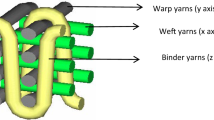Abstract
We developed a processing technique to apply plastic deformation to solid bamboo impregnated with thermosetting resin. To prevent the forming defects such as incomplete filling during upset forgings, we investigated the factors that affect the deformability of the bamboo. We conducted compression tests of the bamboo impregnated with phenol-formaldehyde resin using flat dies. The die temperature and the presence or absence of the lubricant were varied to change the thermal softening/hardening conditions of the impregnated bamboo and the friction characteristics between the bamboo and the dies, respectively. The compressed bamboo samples extended in a perpendicular direction to the bamboo fibers, and the extension ratio (Et) was higher when a lubricant was compared to that in a no-lubricant condition. The change in the Et with temperature was different between the without- and with- lubricant conditions. The results suggest that the friction on the dies significantly affects the deformability of the sample with no lubricant; however, the effect of friction was smaller than that of the flow stress of the bamboo, when the lubricant was used. The polymerization speed of the impregnated resin in the bamboo is also an important factor that affects the deformability of the samples, especially under low-friction conditions. To form a thin and large or complex shape product via flow forming, it is preferable to compress at a low temperature at which the impregnated resin does not polymerize with friction minimized.











Similar content being viewed by others
References
Japan Forestry Agency (2018) Japan Forestry Agency Web. https://www.rinya.maff.go.jp/j/tokuyou/take-riyou/attach/pdf/index-3.pdf. Accessed 19 June 2020
Suhaily SS, Khalil HPSA, Nadirah WOW, Jawaid M (2013) Bamboo based biocomposites material, design and applications. In: Mastai Y (ed) Materials science – advanced topics, Chapter: 19. Intech Publication, London, pp 489–517
Khalil HPSA, Alwani MS, Islam MN, Suhaily SS, Dungani R, H’ng YM, Jawaid M (2015) 16 – the use of bamboo fibres as reinforcements in composites. In: Faruk O, Sain, M. (eds.) Biofiber reinforcements in composite materials, Woodhead Publishing, pp. 488–524. https://doi.org/10.1533/9781782421276.4.488
Khalil HPSA, Bhat IUH, Jawaid M, Zaidon A, Hermawan D, Hadi YS (2012) Bamboo fibre reinforced biocomposites: a review. Mater Des 42:353–368. https://doi.org/10.1016/j.matdes.2012.06.015
Yamashita O, Yokochi H, Imanishi H, Kanayama K (2007) Transfer molding of bamboo. J Mater Proc Tech 192-193(1):259–264. https://doi.org/10.1016/j.jmatprotec.2007.04.011
Yamashita O, Yokochi H, Miki T, Kanayama K (2009) The pliability of wood and its application to molding. J Mater Proc Tech 209(12–13):5239–5244. https://doi.org/10.1016/j.jmatprotec.2008.12.011
Miki T, Seki M, Tanaka S, Shigematsu I, Kanayama K (2014) Advanced wood shaping techniques for sustainable developments. Proc. of 9th sustainable development of energy. SDEWES2014-0085
Miki T, Seki M, Tanaka S, Shigematsu I, Kanayama K (2014) Preparation of three dimensional products using flow deformability of wood treated by small molecular resins. Adv Mater Res 856:79–86. https://doi.org/10.4028/www.scientific.net/AMR.856.79
Miki T, Sugimoto H, Shigematsu I, Kanayama K (2014) Superplastic deformation of solid wood by slipping cells at sub-micrometer intercellular layers. Int J Nanotechnol 11(5/6/7/8):509–519. https://doi.org/10.1504/IJNT.2014.060572
Miki T, Nakaya R, Seki M, Tanaka S, Sobue N, Shigematsu I, Kanayama K (2017) Large deformability derived from a cell–cell slip mechanism in intercellular regions of solid wood. Acta Mech 228(8):2751–2758. https://doi.org/10.1007/s00707-015-1523-z
Seki M, Shigematsu I, Miki T, Kanayama K, Yamada M, Iwawaki K, Yamada T (2018) Acoustic diaphragm made of wood and bamboo materials. Japan Patent, JP 6312122 B2 2018. 4. 18
Seki M, Tanaka S, Miki T, Shigematsu I, Kanayama K (2016) Friction characteristics between metal tool and wood impregnated with phenol formaldehyde (PF) resin during exposure to high pressure. J Wood Sci 62(3):233–241. https://doi.org/10.1007/s10086-016-1551-x
Stamm AJ, Seborg RM (1936) Minimizing wood shrinkage and swelling. Ind Eng Chem 28(10):1164–1169. https://doi.org/10.1021/ie50322a009
Shams MI, Yano H, Endou K (2004) Compressive deformation of wood impregnated with low molecular weight phenol formaldehyde (PF) resin I: effects of pressing pressure and pressure holding. J Wood Sci 50(4):337–342. https://doi.org/10.1007/s10086-003-0570-6
Kalpakjian S (1967) Mechanical processing of materials. Van Nostrand, New York, pp 128–133
Wang XM, Riedl B, Christiansen AW, Geimer RL (1994) Differential scanning calorimetry of the effects of temperature and humidity on phenol-formaldehyde resin cure. Polymer 35(26):5685–5692. https://doi.org/10.1016/S0032-3861(05)80042-4
Acknowledgments
This work was partially supported by Strategic Foundational Technology Improvement Support Operation (Sapoin) 2015 from Ministry of Economy, Trade and Industry (METI).
Author information
Authors and Affiliations
Corresponding author
Ethics declarations
Conflict of interest
The authors declare that they have no conflict of interest.
Additional information
Publisher’s note
Springer Nature remains neutral with regard to jurisdictional claims in published maps and institutional affiliations.
Rights and permissions
About this article
Cite this article
Seki, M., Yashima, Y., Kiryu, T. et al. Deformability of bamboo impregnated with thermosetting resin in upset forging. Int J Mater Form 14, 261–270 (2021). https://doi.org/10.1007/s12289-020-01579-4
Received:
Accepted:
Published:
Issue Date:
DOI: https://doi.org/10.1007/s12289-020-01579-4




